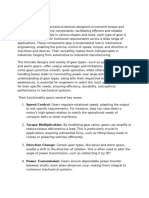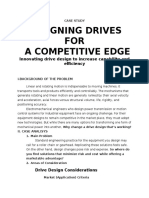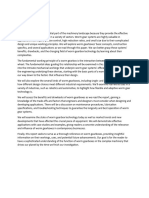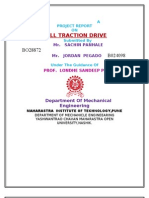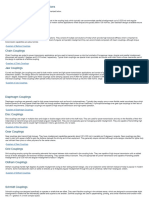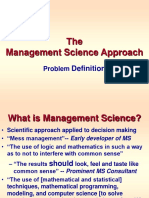Reports 5 8
Reports 5 8
Uploaded by
Cyber RoseCopyright:
Available Formats
Reports 5 8
Reports 5 8
Uploaded by
Cyber RoseOriginal Title
Copyright
Available Formats
Share this document
Did you find this document useful?
Is this content inappropriate?
Copyright:
Available Formats
Reports 5 8
Reports 5 8
Uploaded by
Cyber RoseCopyright:
Available Formats
Cyber Rose C.
Requirme
BET-MT-NS-3B
Mechanical transmission components play a crucial role in various engineering applications,
and understanding the principles of pure contact and rolling bodies, as well as belt drives
and pulleys, is essential for designing efficient and reliable systems. Let's reflect on these
topics:
Pure Contact vs. Rolling Bodies:
Pure Contact: Pure contact mechanisms involve components that transmit motion and power
through direct surface-to-surface contact, such as gears, cams, and sliding mechanisms.
These systems are effective but can experience high levels of friction and wear over time,
necessitating regular maintenance and lubrication.
Rolling Bodies: Rolling bodies, on the other hand, use rolling elements like ball bearings or
cylindrical rollers to reduce friction and distribute loads. This design minimizes wear and
increases efficiency. It's fascinating to consider how these small rolling elements enable
smooth, long-lasting motion in various applications, from bicycles to industrial machinery.
Rolling Cones and Pure Rolling Contact:
Rolling Cones: Rolling cones are an interesting concept, often found in tapered roller
bearings. The conical shape allows for both radial and axial load-bearing capabilities. It's
fascinating how such a simple geometric shape can provide versatile mechanical
advantages while maintaining contact through pure rolling.
Pure Rolling Contact: Pure rolling contact is a fundamental principle in mechanical
engineering. It ensures that two components rotate without slipping against each other,
minimizing energy loss due to friction. Achieving pure rolling contact is essential for efficient
transmission of power and motion.
Belt Drives and Pulleys:
Belt Drive Systems: Belt drives are widely used in various applications, from automotive
engines to conveyor systems. They offer flexibility in transferring power over long distances,
dampening vibration, and reducing noise. Belt drives are also cost-effective and require less
maintenance compared to direct mechanical linkages.
Pulleys: Pulleys are critical components of belt drive systems, serving as the interface
between the belt and the rotating shaft. Understanding the design and selection of pulleys is
essential for optimizing belt drive systems for specific applications. The choice of pulley size,
shape, and material can significantly impact system performance.
In conclusion, mechanical transmission components, whether they involve pure contact,
rolling bodies, or belt drives, are fundamental to the functioning of countless machines and
devices in our daily lives. Engineers and designers must carefully consider these principles
to create efficient, durable, and reliable systems. The balance between friction and rolling
contact, along with the proper selection of components like pulleys and belts, is crucial for
achieving optimal performance in various mechanical applications.
You might also like
- Vantio CacheServe 7.2.0 Administrators Manual 20161208 PDF100% (1)Vantio CacheServe 7.2.0 Administrators Manual 20161208 PDF577 pages
- APW-100 Ricardo Generator Technical Specification Sheet PDFNo ratings yetAPW-100 Ricardo Generator Technical Specification Sheet PDF4 pages
- An Overview of The Most Popular Rotary Motion Technologies - Medical Design BriefsNo ratings yetAn Overview of The Most Popular Rotary Motion Technologies - Medical Design Briefs8 pages
- Torsional Vibration, Gear Trains and Cam and FollowerNo ratings yetTorsional Vibration, Gear Trains and Cam and Follower5 pages
- Linear Systems 101 Basics For Design Engineers TaenNo ratings yetLinear Systems 101 Basics For Design Engineers Taen7 pages
- Chapter 6: Mechanical Equipment Maintenance 6.2 GEARS0% (1)Chapter 6: Mechanical Equipment Maintenance 6.2 GEARS5 pages
- Transmisiones Flexibles: Nelson H Grimaldo Caldera Transmisiones Flexibles Maestra: Dania Honstein Dinámica de MaquinasNo ratings yetTransmisiones Flexibles: Nelson H Grimaldo Caldera Transmisiones Flexibles Maestra: Dania Honstein Dinámica de Maquinas5 pages
- RM 1016 US-e HM Series Modular Balancing MachinesNo ratings yetRM 1016 US-e HM Series Modular Balancing Machines26 pages
- Types of Couplings and Their ApplicationsNo ratings yetTypes of Couplings and Their Applications12 pages
- Bearings And Bearing Metals: A Treatise Dealing with Various Types of Plain Bearings, the Compositions and Properties of Bearing Metals, Methods of Insuring Proper Lubrication, and Important Factors Governing the Design of Plain BearingsFrom EverandBearings And Bearing Metals: A Treatise Dealing with Various Types of Plain Bearings, the Compositions and Properties of Bearing Metals, Methods of Insuring Proper Lubrication, and Important Factors Governing the Design of Plain Bearings4/5 (1)
- 2014 05 08 Brochure HVDC Theory and Controls and Project Management V7No ratings yet2014 05 08 Brochure HVDC Theory and Controls and Project Management V72 pages
- Oral Health and Salivary Status in Children With Type 1 Diabetes MellitusNo ratings yetOral Health and Salivary Status in Children With Type 1 Diabetes Mellitus8 pages
- Wsa Full Stack Web Developer Course SyllabusNo ratings yetWsa Full Stack Web Developer Course Syllabus17 pages
- Solved RRB JE 1st June 2019 Shift-3 Paper With SolutionsNo ratings yetSolved RRB JE 1st June 2019 Shift-3 Paper With Solutions39 pages
- Ma1512 Cheatsheet Summary Differential Equations For EngineeringNo ratings yetMa1512 Cheatsheet Summary Differential Equations For Engineering4 pages
- Translating Hikayat Deli Into Bahasa Indonesia and The Need of Meaning-Based Translation ModelNo ratings yetTranslating Hikayat Deli Into Bahasa Indonesia and The Need of Meaning-Based Translation Model6 pages
- Class - VI Mathematics (Ex. 9.1) Questions: Portal For CBSE Notes, Test Papers, Sample Papers, Tips and TricksNo ratings yetClass - VI Mathematics (Ex. 9.1) Questions: Portal For CBSE Notes, Test Papers, Sample Papers, Tips and Tricks14 pages
- Jewar Airport-OLS and Topographic Surey ReportNo ratings yetJewar Airport-OLS and Topographic Surey Report13 pages
- The Management Science Approach: ProblemNo ratings yetThe Management Science Approach: Problem14 pages














